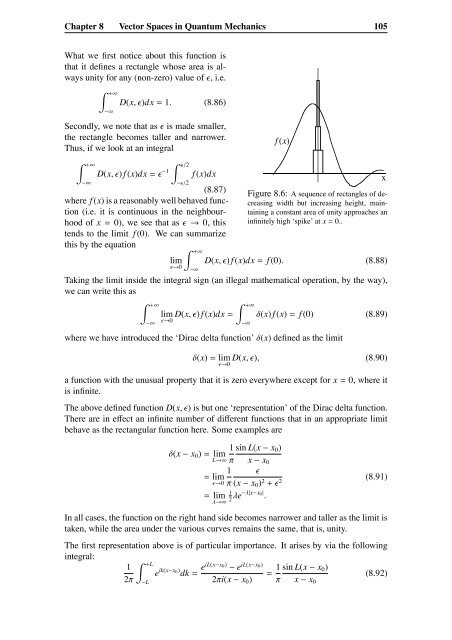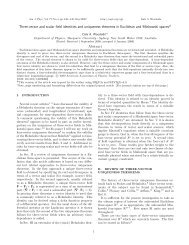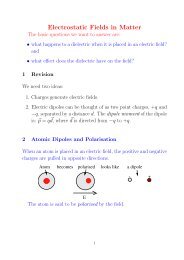Chapter 8 Vector Spaces in Quantum Mechanics
Chapter 8 Vector Spaces in Quantum Mechanics
Chapter 8 Vector Spaces in Quantum Mechanics
You also want an ePaper? Increase the reach of your titles
YUMPU automatically turns print PDFs into web optimized ePapers that Google loves.
<strong>Chapter</strong> 8 <strong>Vector</strong> <strong>Spaces</strong> <strong>in</strong> <strong>Quantum</strong> <strong>Mechanics</strong> 105What we first notice about this function isthat it def<strong>in</strong>es a rectangle whose area is alwaysunity for any (non-zero) value of ɛ, i.e.∫ +∞−∞D(x, ɛ)dx = 1. (8.86)Secondly, we note that as ɛ is made smaller,the rectangle becomes taller and narrower.Thus, if we look at an <strong>in</strong>tegralf (x)∫ +∞−∞∫ ɛ/2D(x, ɛ) f (x)dx = ɛ −1 f (x)dx−ɛ/2(8.87)where f (x) is a reasonably well behaved function(i.e. it is cont<strong>in</strong>uous <strong>in</strong> the neighbourhoodof x = 0), we see that as ɛ → 0, thistends to the limit f (0). We can summarizethis by the equationFigure 8.6: A sequence of rectangles of decreas<strong>in</strong>gwidth but <strong>in</strong>creas<strong>in</strong>g height, ma<strong>in</strong>ta<strong>in</strong><strong>in</strong>ga constant area of unity approaches an<strong>in</strong>f<strong>in</strong>itely high ‘spike’ at x = 0..∫ +∞lim D(x, ɛ) f (x)dx = f (0). (8.88)ɛ→0−∞Tak<strong>in</strong>g the limit <strong>in</strong>side the <strong>in</strong>tegral sign (an illegal mathematical operation, by the way),we can write this as∫ +∞−∞lim D(x, ɛ) f (x)dx =ɛ→0∫ +∞−∞δ(x) f (x) = f (0) (8.89)where we have <strong>in</strong>troduced the ‘Dirac delta function’ δ(x) def<strong>in</strong>ed as the limitδ(x) = limɛ→0D(x, ɛ), (8.90)a function with the unusual property that it is zero everywhere except for x = 0, where itis <strong>in</strong>f<strong>in</strong>ite.The above def<strong>in</strong>ed function D(x, ɛ) is but one ‘representation’ of the Dirac delta function.There are <strong>in</strong> effect an <strong>in</strong>f<strong>in</strong>ite number of different functions that <strong>in</strong> an appropriate limitbehave as the rectangular function here. Some examples are1 s<strong>in</strong> L(x − x 0 )δ(x − x 0 ) = limL→∞ π x − x 01 ɛ= lim(8.91)ɛ→0 π (x − x 0 ) 2 + ɛ 21= limλ→∞ 2 λe−λ|x−x 0| .In all cases, the function on the right hand side becomes narrower and taller as the limit istaken, while the area under the various curves rema<strong>in</strong>s the same, that is, unity.The first representation above is of particular importance. It arises by via the follow<strong>in</strong>g<strong>in</strong>tegral:∫1 +Le ik(x−x0) dk = eiL(x−x0) − e iL(x−x 0)= 1 s<strong>in</strong> L(x − x 0 )(8.92)2π −L2πi(x − x 0 ) π x − x 0x
















